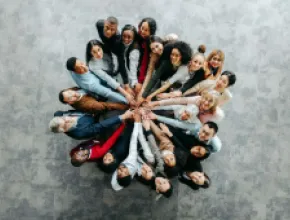New Orleans knows a thing or two about reinvention. Celebrating its 300th birthday this year, the city is brimming with confidence—a very different New Orleans than I saw in 2005 on my last visit, just a few months after the devastation of Hurricane Katrina.
My host in the city was the NOPSI Hotel, the latest addition to New Orleans’ bustling Central Business District. NOPSI also knows a few things about reinvention.
Housed in the former old headquarters for the New Orleans Public Service Inc. power and transportation company, the hotel, a Salamander Hotels & Resorts property, repurposed a nine-story brick building that sat vacant for more than 30 years and last summer took the wraps off a complete redesign.
“I remember when my mom used to come here to pay the bills,” NOPSI Director of Sales and Marketing Brett Forshag said during my recent four-day NOLA fam trip.
The design of the hotel logo is a nod to the NOPSI manhole covers that are still underfoot all over the city. Inside, the 217-room property is peppered with locally themed art and NOPSI memorabilia such as old transit tickets and photos.
NOPSI General Manager Ellen LeMaire said she tells staff to talk about the background of the hotel to visitors and “appreciate our history.”
Along with its history, NOPSI focuses on its culinary and cocktail scene. Forshag and company kept us fed and imbibed, starting with first night drinks at the underCURRENT Bar & Patio, set under the vaulted ceilings of the hotel lobby. We dined on everything from black-bean hummus to whole-roasted Gulf fish at Public Service, and topped the first evening with city views from Above the Grid, the hotel’s rooftop bar and pool.
As much as we indulged in food and drink at NOPSI, we also ventured to some of the city’s legendary standards, including a local tradition, Friday lunch at Galatoire’s. Fortunately, our group had hired a professional line holder (Yes, it’s a thing!) to sit and wait for a hard-to-get table since the restaurant doesn’t take reservations.
The room was spilling with generations of New Orleans money—Saints football executives, former debutants. We even witnessed a brass band romp through the restaurant in honor of someone’s birthday.
Not to be outdone, we invested several hours in Saturday brunch at the legendary Brennan’s, its pink facade and elegant interior the backdrop for some heavy flavors, including vanilla-scented French toast, Cajun bloody Mary’s and its signature bananas Foster desserts.
We also ventured to newer spots like Maypop in the Warehouse District, blending Southeast Asian and Southern cuisine … and the ubiquitous craft cocktails.
Even better than partaking in the New Orleans cocktail scene, we actually learned how to make our own at Drink Lab, run by Daniel Victory and Camille Whitworth. We each had our own station with various liquors, and under the guidance of Victory created classics like the Sazerac, Hurricane and the Ramos Gin Fizz.
Lulu White’s mugshot over the bar added local flavor.
“She was the most over-the-top, gregarious, dripping with jewelry madam of that time,” Victory said.
Drink Lab caters to groups of up to 36 with private mixology and spirits tasting classes.
Between events we had time to wander the French Quarter, alive with street musicians, horse-drawn carriages, art galleries and in Jackson Square, caricaturists, palm readers, tarot card specialists and self-proclaimed psychics. Along nearby Frenchmen Street in the Faubourg Marigny area music blared out of bars like The Spotted Cat Music Club and Maison.
In the Quarter, I checked out the Historic New Orleans Collection history museum; Voodoo Museum, a tiny space overflowing with altars and voodoo history; and the Museum of Death, focusing on serial killers, morbid video footage and more.
While the French Quarter is thankfully much the same since my last visit, the Warehouse, or Arts District of New Orleans (ADNO), has blossomed with a dozen galleries, restaurants, bars and museums.
“I can’t tell you how much the area has changed,” said our walking-tour guide, Leslie-Claire Spillman, director of Soren Christensen Gallery.
Buildings that house many galleries were warehouses before the 1984 World’s Fair, and then later were offered as gallery space to local artists.
“Now it’s one of the richest areas of the city,” she said.
The area is also filled with impressive cultural venues that have enough space for groups, including the sprawling National WWII Museum, brought to life with videos, personal stories and interactive exhibits.
On my visit in 2005, the Lower Ninth Ward, which was largely under water after Hurricane Katrina, was in shambles. Out of curiosity, this visit I ventured to the tiny Lower Ninth Ward Living Museum, featuring displays about the turbulent history of that area, which is still struggling to make a comeback.
Still, New Orleans at 300 has much to celebrate, and we did. During our farewell evening at NOPSI we were treated to a private dinner with the hotel’s executive chef, Peter Page, in the Dryades Ballroom, formerly a loading area during the building’s years in the utility industry.
NOPSI held our sendoff champagne toast in the Power Suite replete with patio views of the city lights, as a reimagined NOLA showed she’s only getting better with age.
NOPSI Hotel
844.439.1463
www.nopsihotel.com
New Orleans CVB
504.566.5011
www.neworleans.com







